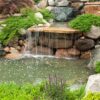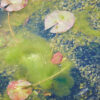How do I remove the silt from my pond? How to fight against this accumulation of organic matter: sludge, silt, in the pond? All you need to know about the treatment of silt in ponds.
Muddy water in a pond affects the appearance of the pond and makes life uncomfortable for the fish. It can also cause fish to die. If you own a pond, it can be a nuisance to you. Water becomes muddy for biological, chemical and even wildlife reasons. This article explains why pond water becomes muddy and also shows you how to clean muddy pond water.
Excessive Mud and Clay In The Pond
Additional mud and clay particles can be found at the bottom of the pond or enter the pond from the sides. These mud and clay particles will make the pond muddy and mushy when they are suspended in the water. Rainwater is the vehicle for these particles. Rainwater carries these particles from the edge of the pond into the pond and makes the water muddy. In some cases, temporary streams carry particles away from the edge of the pond and make the water muddy.
Clay can carry differently charged particles that repel each other. For this reason, clay particles tend to stay suspended in the pond water. As a result, this makes the water cloudy.

Causes of Silt In The Pond
Wildlife
Fish, ducks, and other animals can also make the water muddy in a pond. Having extra fish, especially the bottom feeder, can also be a reason for this. Moreover, their frequent movements stir up the bottom soil and create a clay suspension in the water.
Incorrect filtration
Poor filtration can cause cloudy water in the pond. There can be two scenarios. Either you are using a filter that is too small, or the filter media is not efficient enough to filter out the clay particles. Due to the lack of filtration of the clay particles, the water becomes muddy and cloudy.
Runoff from heavy rainfall
Due to heavy rainfall, mud and clay that is far from the pond finds a way to come into the pond. This will happen every time after a heavy rainfall if there is no device to prevent the runoff from entering the pond. This problem is most prevalent in countries where there is an excess of rainfall during the calendar year.
Soil erosion
Soil erosion is another reason why pond water becomes cloudy. The real cause is river banks in this scenario. Many chemicals used in the pond can loosen the soil. Clay particles from the loose soil move into the water and make it cloudy.
Chemical imbalance
The chemical imbalance in the pond causes the water color to become cloudy at times. And this results in an uncomfortable situation for the wildlife that must survive in the pond. Different chemical agents like ammonium, carbonate, nitrate and the right amount of pH must be present in the water. If any of these elements are not present in the right ratio, the pond is chemically imbalanced and this contributes to the pond water becoming muddy.
Treatment Of Silt: How to drain the water from the muddy pond
Try filtering mud and clay
It is essential to use a good filter system to remove clay from the pond water. The filter will remove the sludge and clay from your pond. The mechanical filter is much more effective for this purpose. It would help if you ensure that the filter you use is the right size for the pond’s fish load and water load. If you already have the right size, check the filter media to make sure it is working properly. Consequently, it is not, then replace it. If your filter is not large enough, buy a new one that can handle the load.
Test the water in your pond and take the necessary measures
To find the exact problem, you need to test the water quality of the pond. There are test kits available to test the water. The sera test kit is recommended for testing pond water (pond or natural pond). You can do 500 tests with this kit. They can give quite quick and accurate results regarding the water quality of the pond and you can identify the reasons why the water becomes cloudy from the result. Most test kits also give the pH range, nitrate level, ammonia level and KH. From this you can easily determine if you can have fish in your pond. Fish prefer a narrow pH range in the water. The pH range should be 6.5 to 8.5. If you find that the pH is not up to par, you can add household vinegar to lower it and restore the balance.
The presence of the proper amount of bicarbonate ions in the pond water is important to ensure that the water has its normal color and does not become muddy. Thus, by testing the water, you can determine the cause of the problem and take the necessary steps to remedy it.
Create a wildlife barrier
Do not keep any animals in your pond that could harm the pond ecosystem. You can build a fence around your pond to keep wildlife out. The animals will leave extra waste. This extra waste will become food for the algae after it decomposes. To protect yourself from birds, you can use a net over the pond.
Add plants that remove cloudy water from the pond
Some plants can naturally remove cloudy water from ponds. Most of these plants are floating pond plants. Their root system is developed in such a way that they can pull mud and clay particles through them. They can also remove heavy metals from your pond.
To clean muddy pond water, water hyacinth, water lettuce, duckweed, pigtail are effective. Add them to your pond to remove cloudy water without chemicals. But make sure they don’t cover all the water surfaces.
Filter maintenance
It is quite common that your pond is equipped with the right filter, but the water is muddy for no reason. In this case, you should check the filter media. Most likely, the media is not working properly because it has lost its efficiency. If this happens, change the filter. You should also wash your backwash filter regularly to effectively remove clay particles.
Aerate your pond to reduce sludge and silt
Aeration induces oxygen in the water. It also reduces sludge and dirt. There will be less nutrients in the pond water. This can go a long way in getting the water clean again. You can use Natural Waterscapes cleaning pellets to quickly remove the sludge.
Is there a good time to suck up silt?
It will depend on the quantity and total volume. The best time to clean out a pond is in the fall. Spring is always more complicated for the fauna and flora.
_______________________________________________________________________
Aquigarden is reader-supported by Adsense & Amazon LLC. When you buy throug links on our tips site, we may earn an affiliate commission. Learn more. Aquigarden is a participant in the Amazon Services LLC Associates Program, an affiliate advertising program designed to provide a means of sites to earn lead fees by linking to Amazon.com
We only give our own opinion. We only give our own opinion. We do not accept any liability. We recommend that you always call in a professional in pond & pool.










